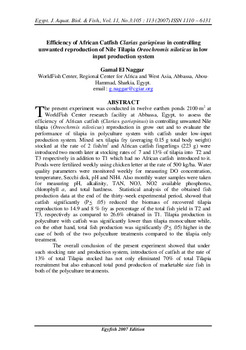Please use this identifier to cite or link to this item:
https://hdl.handle.net/20.500.12348/1726
Efficiency of African catfish Clarias gariepinus in controlling unwanted reproduction of Nile tilapia Oreochromis niloticus in low input production system
| dc.creator | El Naggar, G. | |
| dc.date.accessioned | 2018-11-06T10:28:49Z | |
| dc.date.available | 2018-11-06T10:28:49Z | |
| dc.date.issued | 2007 | |
| dc.identifier | WF_951.pdf | |
| dc.identifier.citation | Egyptian journal of aquatic biology and fisheries 11(3):105-113 | |
| dc.identifier.issn | 1110-6131 | |
| dc.identifier.uri | https://hdl.handle.net/20.500.12348/1726 | |
| dc.description.abstract | The present experiment was conducted in twelve earthen ponds 2100-m2 at WorldFish Center research facility at Abbassa, Egypt, to assess the efficiency of African catfish (Clarias gariepinus) in controlling unwanted Nile tilapia (Oreochrmis niloticus) reproduction in grow out and to evaluate the performance of tilapia in polyculture system with catfish under low-input production system. Mixed sex tilapia fry (averaging 0.15 g total body weight) stocked at the rate of 2 fish/m2 and African catfish fingerlings (223 g) were introduced two month later at stocking rates of 7 and 13% of tilapia into T2 and T3 respectively in addition to T1 which had no African catfish introduced to it. Ponds were fertilized weekly using chicken letter at the rate of 500 kg/ha. Water quality parameters were monitored weekly for measuring DO concentration, temperature, Secchi disk, pH and NH4. Also monthly water samples were taken for measuring pH, alkalinity, TAN, NO3, NO2 available phosphorus, chlorophyll a, and total hardness. Statistical analysis of the obtained fish production data at the end of the thirty-week experimental period, showed that catfish significantly (P< .05) reduced the biomass of recovered tilapia reproduction to 14.9 and 8 % fry as percentage of the total fish yield in T2 and T3, respectively as compared to 26.6% obtained in T1. Tilapia production in polyculture with catfish was significantly lower than tilapia monoculture while, on the other hand, total fish production was significantly (P< .05) higher in the case of both of the two polyculture treatments compared to the tilapia only treatment. The overall conclusion of the present experiment showed that under such stocking rate and production system, introduction of catfish at the rate of 13% of total Tilapia stocked has not only eliminated 70% of total Tilapia recruitment but also enhanced total pond production of marketable size fish in both of the polyculture treatments. | |
| dc.format | application/pdf | |
| dc.language | En | |
| dc.publisher | Egyptian Society for the Development of Fisheries and Human Health | |
| dc.source | Egyptian Journal of Aquatic Biology and Fisheries | |
| dc.title | Efficiency of African catfish Clarias gariepinus in controlling unwanted reproduction of Nile tilapia Oreochromis niloticus in low input production system | |
| dc.type | Journal Article | |
| dcterms.bibliographicCitation | El Naggar, G. (2007). Efficiency of African catfish Clarias gariepinus in controlling unwanted reproduction of Nile tilapia Oreochromis niloticus in low input production system. Egyptian journal of aquatic biology and fisheries 11(3):105-113 | |
| dc.description.version | Peer Review | |
| cg.coverage.country | Egypt | |
| cg.identifier.worldfish | 951 | |
| cg.subject.agrovoc | fish larvae | |
| cg.subject.agrovoc | polyculture | |
| cg.subject.agrovoc | reproduction | |
| cg.subject.agrovoc | statistical methods | |
| cg.subject.agrovoc | tilapia | |
| cg.subject.worldfish | catfish | |
| cg.subject.worldfish | stocking | |
| cg.subject.worldfish | fry | |
| cg.subject.worldfish | statistical analysis | |
| cg.identifier.status | Open access | |
| cg.contribution.worldfishauthor | El Naggar, G. | |
| cg.description.theme | Sustainable aquaculture | |
| worldfish.location.area | Africa |
Files in this item
This item appears in the following Collection(s)
-
Sustainable aquaculture [2738]
